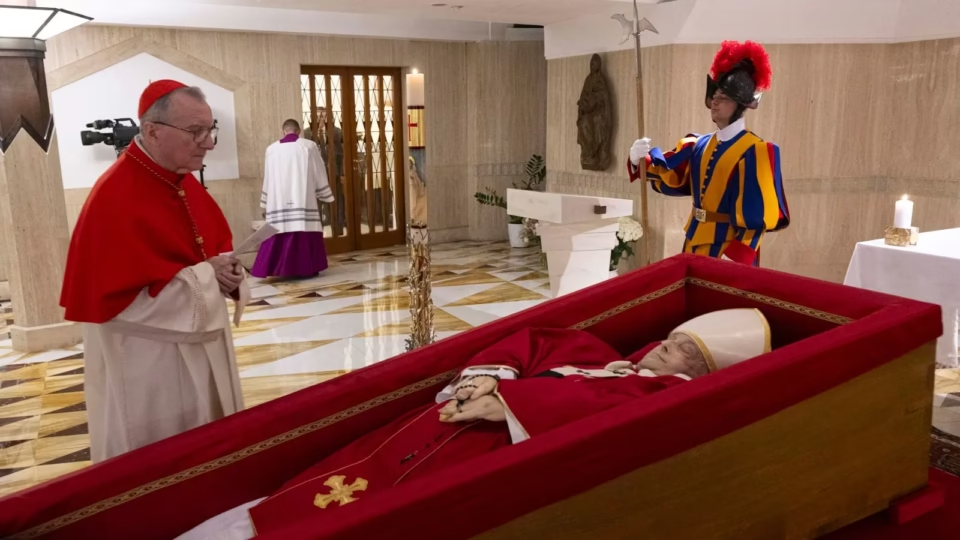The Vatican has officially announced the passing of Pope Francis, who died on Easter Monday, April 21, 2025, at 7:35 AM, at the age of 88. His death occurred at his residence, Casa Santa Marta, following several months of declining health due to chronic respiratory complications.
As preparations begin for the funeral rites, the Holy See has also released the Pope’s spiritual testament, written on June 29, 2022, in which he humbly outlines his final wishes for burial—highlighting a life lived in deep faith, humility, and devotion to the Blessed Virgin Mary
On Wednesday, April 23, the body of Pope Francis will be transferred from Casa Santa Marta to St. Peter’s Basilica in a solemn procession. The procession, led by Cardinal Kevin Farrell, Camerlengo of the Holy Roman Church, will begin at 9:00 AM and move through Santa Marta Square, the Square of the Roman Protomartyrs, and the Arch of the Bells before entering the Basilica through its central doors.
Upon arrival at the Altar of the Confession, Cardinal Farrell will preside over the Liturgy of the Word, after which the faithful will be welcomed to pay their final respects during the Pope’s lying in state
The funeral Mass will take place on Saturday, April 26, at 10:00 AM in St. Peter’s Basilica. Cardinal Giovanni Battista Re, Dean of the College of Cardinals, will preside, joined by patriarchs, bishops, and clergy from around the world.
The liturgy will conclude with the Ultima commendatio and Valedictio, marking the start of the Novemdiales—nine days of mourning and prayer for the repose of the Pope’s soul.
In accordance with his final wishes, Pope Francis will not be interred in St. Peter’s Basilica but rather transferred afterward to the Papal Basilica of Saint Mary Major, a place of deep personal devotion.
In his spiritual testament, Pope Francis expressed a desire for simplicity in death, mirroring the humility with which he led the Church.
“Throughout my life, and during my ministry as a priest and bishop, I have always entrusted myself to the Mother of Our Lord, the Blessed Virgin Mary,” he wrote. “For this reason, I ask that my mortal remains rest—awaiting the day of the Resurrection—in the Papal Basilica of Saint Mary Major.”
He specified that his tomb be located between the Pauline Chapel (which houses the icon Salus Populi Romani) and the Sforza Chapel, in a ground-level niche. The tomb, he insisted, should be “simple, without particular ornamentation, bearing only the inscription: Franciscus.”
The burial expenses will be covered by a benefactor, with arrangements made through Cardinal Rolandas Makrickas, Extraordinary Commissioner of the Liberian Basilica.
“The suffering that has marked the final part of my life, I offer to the Lord,” he added, “for peace in the world and for fraternity among peoples.”
Born Jorge Mario Bergoglio in Buenos Aires in 1936, Pope Francis became the first Jesuit, the first Latin American, and the first non-European pope in over a thousand years. Elected in 2013, he led the Catholic Church through an era marked by calls for reform, deeper compassion, and renewed focus on the marginalized.
His final months were marked by illness. After being hospitalized in February with bronchitis and later diagnosed with bilateral pneumonia, he spent 38 days at the Agostino Gemelli Polyclinic Hospital before returning to the Vatican. Though he continued his ministry in private, his health declined further in April.
At the time of his death, Pope Francis was surrounded by close aides and members of his household. His passing was formally announced by Cardinal Farrell from Casa Santa Marta.
In April 2024, Pope Francis personally approved a revised edition of the Ordo Exsequiarum Romani Pontificis, simplifying the traditional papal funeral rites.
“The renewed rite,” explained Archbishop Diego Ravelli, Master of Apostolic Ceremonies, “seeks to emphasise even more that the funeral of the Roman Pontiff is that of a pastor and disciple of Christ, not of a powerful person of this world.”
As the world begins nine days of mourning, Pope Francis’ legacy endures—not only in his reforms and teachings but in the humility of a man who asked to be remembered simply as Franciscus, resting quietly at the feet of Mary, whom he loved so dearly.



